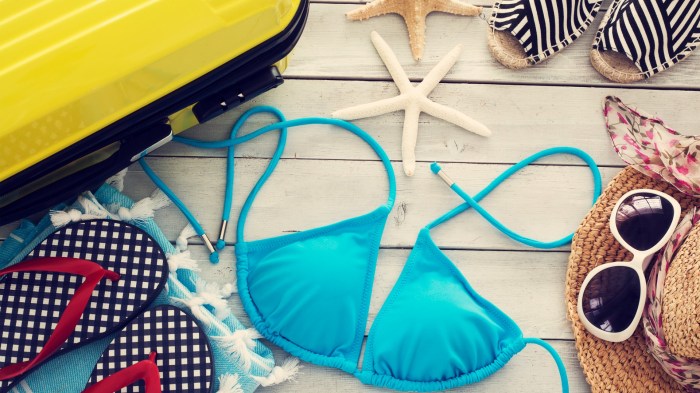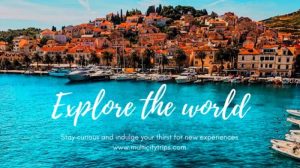
Dreaming of a sun-kissed beach vacation but dreading the packing process? Transform your travel experience from stressful to seamless with these expert tips. We’ll guide you through efficient packing strategies, essential item checklists, and clever hacks to ensure you maximize space and minimize packing woes, leaving you with more time to relax and enjoy your well-deserved getaway.
This comprehensive guide covers everything from creating a versatile capsule wardrobe to utilizing packing cubes and avoiding common packing mistakes. We’ll delve into practical techniques for organizing your belongings, choosing the right attire for various beach activities, and even offer advice on capturing stunning vacation photos. Prepare for a stress-free packing experience that allows you to focus on the fun parts of your trip!
Beach Vacation Outfits & Accessories
Packing for a beach vacation requires careful consideration of both functionality and style. Choosing versatile outfits and essential accessories will ensure you’re prepared for a range of activities, from sunbathing to evening dinners, while minimizing the amount of luggage you need to carry. Prioritizing lightweight, quick-drying fabrics will also enhance your comfort in the warm and humid climate.
Planning your wardrobe strategically is key to a stress-free and stylish beach getaway. Consider the activities you’ll be participating in and select clothing items that can be mixed and matched to create multiple outfits. Don’t forget to pack appropriate accessories to protect yourself from the sun and enhance your overall beach look.
Versatile Beach Outfits
Creating a capsule wardrobe for your beach trip involves selecting a few key items that can be mixed and matched to create a variety of outfits. This approach helps minimize packing space while ensuring you have appropriate attire for all your planned activities. The following table showcases example outfit combinations:
| Outfit | Top | Bottom | Shoes |
|---|---|---|---|
| Swimming | Swimsuit | (None) | Flip-flops |
| Beach Day | Flowy sundress | (N/A) | Sandals |
| Casual Dinner | Lightweight linen shirt | Shorts or linen pants | Espadrilles |
| Sightseeing | Tank top | Capri pants | Comfortable walking shoes |
Essential Beach Accessories
In addition to clothing, several accessories are crucial for a comfortable and enjoyable beach vacation. These items provide protection from the sun and enhance your overall experience.
- Wide-brimmed sun hat: Protects your face and neck from harmful UV rays.
- Sunglasses: Shield your eyes from the sun’s glare and prevent squinting.
- High SPF sunscreen: Essential for protecting your skin from sunburn.
- Beach towel: A large, absorbent towel for drying off after swimming.
- Reusable water bottle: Staying hydrated is crucial in warm weather.
- Beach bag: A large tote bag to carry your essentials.
Seven-Day Beach Vacation Capsule Wardrobe
A well-planned capsule wardrobe can significantly reduce the amount of luggage you need to pack. The following is an example of a seven-day beach vacation capsule wardrobe, focusing on versatile items that can be mixed and matched.
- Two swimsuits
- Two sundresses
- One pair of shorts
- One pair of linen pants or a skirt
- Three lightweight tops (tank tops, t-shirts)
- One light cardigan or cover-up
- One pair of sandals
- One pair of walking shoes
- Underwear and socks
Lightweight and Quick-Drying Fabrics
Choosing lightweight and quick-drying fabrics is crucial for comfort and practicality during a beach vacation. These fabrics will help you stay cool and comfortable in the heat and humidity, and they’ll dry quickly if they get wet from swimming or unexpected rain showers. Examples of suitable fabrics include linen, cotton, rayon, and quick-drying synthetic blends.
Travel Hacks for Beach Vacations
Packing for a beach vacation can feel overwhelming, but with a few clever strategies, you can significantly reduce stress and travel lighter. These travel hacks focus on streamlining your packing process, maximizing space, and minimizing the risk of overpacking, ultimately leading to a more enjoyable and relaxed trip.
Packing Organizers: Benefits and Drawbacks
Packing organizers, such as cubes, folders, and pouches, offer a structured approach to packing. Their benefits include improved organization, easier access to items, and compression of clothing to save space, particularly helpful in smaller suitcases or carry-on bags. However, the drawbacks include the added weight and bulk of the organizers themselves, potentially negating some space savings, especially if using numerous, large organizers.
The effectiveness of packing organizers also depends on the type of luggage used; they are particularly beneficial for soft-sided luggage, which can be compressed, while their impact might be less pronounced with hard-shell suitcases. Choosing the right size and type of organizer for your specific needs is crucial.
Avoiding Overpacking Through Strategic Planning
Overpacking is a common issue, easily avoided with careful planning. Create a detailed packing list based on your itinerary, considering the planned activities for each day. For example, if you plan three days of beach activities, three swimsuits and cover-ups are sufficient, rather than packing your entire wardrobe. Choose versatile clothing items that can be mixed and matched to create multiple outfits.
Neutral-colored bottoms paired with several different tops can significantly reduce the number of items needed. Remember to account for laundry facilities at your destination; packing less becomes easier if you can wash clothes mid-vacation.
Five Practical Travel Hacks
Implementing a few simple strategies can significantly improve your packing efficiency.
- Roll, Don’t Fold: Rolling your clothes saves space and minimizes wrinkles compared to folding.
- Utilize Empty Space: Stuff socks and underwear into shoes to maximize space and protect shoes from damage.
- Wear Your Bulkiest Items: Wear your heaviest shoes and jacket on the plane to save luggage space.
- Use Travel-Sized Containers: Transfer toiletries into travel-sized containers to comply with airline regulations and save space.
- Leave Unnecessary Items Behind: Be honest about what you truly need. Consider leaving behind items you might use infrequently.
Common Packing Mistakes and Solutions
Three frequent packing mistakes are often easily remedied.
- Packing Too Many Shoes: Shoes occupy significant space. Limit the number to those absolutely essential for planned activities. Consider wearing the bulkiest pair during travel.
- Ignoring Weather Conditions: Failing to check the weather forecast before packing can lead to packing inappropriate clothing. Check the forecast and pack accordingly, avoiding unnecessary items.
- Not Utilizing Compression Bags: Compression bags can significantly reduce the volume of clothing, freeing up valuable space in your luggage. These are especially helpful for soft, bulky items like sweaters and towels.
Travel Insurance and Visa Requirements
Planning a beach vacation involves more than just packing your bags and booking flights. Ensuring a smooth and worry-free trip requires careful consideration of travel insurance and visa requirements, especially for international destinations. These two aspects are crucial for protecting your investment and ensuring legal compliance throughout your journey.Travel insurance offers financial protection against unforeseen circumstances that could disrupt your vacation plans or result in unexpected expenses.
Visa requirements, on the other hand, are legal obligations that determine your eligibility to enter a foreign country. Understanding both is essential for responsible travel planning.
Types of Travel Insurance Policies
Travel insurance policies vary significantly in their coverage. Choosing the right policy depends on your individual needs and the nature of your trip. Common types include basic travel insurance, comprehensive travel insurance, and specialized policies catering to specific activities like adventure sports or backpacking. Basic policies typically cover trip cancellations and medical emergencies, while comprehensive policies offer broader coverage, including lost luggage, flight delays, and personal liability.
Specialized policies offer coverage tailored to the specific risks associated with particular activities. For example, adventure travel insurance might cover rescue operations in remote areas. Comparing policies from different providers is crucial to find the best value and coverage for your specific needs.
Obtaining Travel Visas
The process of obtaining a travel visa varies greatly depending on your nationality and your destination country. Some countries offer visa-free entry to citizens of certain countries, while others require visas obtained in advance. The application process usually involves completing an online application form, providing supporting documents such as passport photos, proof of accommodation, and flight itineraries, and paying the visa fee.
Processing times can range from a few days to several weeks, so it’s essential to apply well in advance of your planned travel dates. Failure to obtain the necessary visa can result in being denied entry at the border. It’s advisable to check the specific visa requirements for your destination country well in advance through your destination country’s embassy or consulate website.
Checklist of Documents for International Travel
Thorough preparation is key to a successful international trip. This checklist highlights essential documents to ensure a smooth travel experience. Failing to have these documents in order can lead to delays and complications at airports and border crossings.
- Passport (valid for at least six months beyond your return date)
- Visa (if required)
- Travel insurance policy details (including contact information)
- Flight and accommodation confirmations
- Copies of important documents (passport, visa, insurance policy, etc.)
- Emergency contact information
- Travel itinerary
Travel Photography Tips for Beach Vacations

Capturing the essence of a beach vacation through photography requires more than just pointing and shooting. Understanding light, composition, and editing techniques can elevate your beach photos from snapshots to stunning memories. This section provides practical tips and a sample itinerary to help you achieve professional-looking beach photography.
Utilizing Natural Light for Beach Photography
Natural light is the key to vibrant and captivating beach photography. The best time to shoot is during the “golden hour,” the hour after sunrise and the hour before sunset. During these times, the sun is lower in the sky, casting a warm, soft light that minimizes harsh shadows and creates a magical atmosphere. Midday sun, while bright, often results in harsh contrasts and washed-out colors.
Shooting in the shade during midday can also be a good option, providing softer light. Experiment with backlighting – positioning the sun behind your subject can create silhouettes and dramatic effects. Consider using a reflector to bounce light back onto your subject, filling in shadows and enhancing details.
Composition Techniques for Striking Beach Photographs
Effective composition is crucial for impactful beach photos. The rule of thirds, a fundamental principle in photography, suggests placing your main subject off-center, approximately one-third of the way into the frame, either horizontally or vertically. This creates a more visually appealing and balanced image. Leading lines, such as a winding shoreline or a path leading to the sea, can draw the viewer’s eye into the photograph.
Framing, using elements like rocks, arches, or trees, can add depth and context to your shots. Consider different perspectives – shoot from low angles to emphasize the vastness of the sky or from high angles to capture the texture of the sand and the arrangement of beachgoers.
Photography Itinerary for a Beach Vacation
A planned approach can ensure you capture the diverse aspects of your beach trip. Consider this sample itinerary:Day 1: Sunrise shot at the beach capturing the tranquility of the early morning. Midday: Focus on capturing details – seashells, footprints in the sand, beach textures. Sunset: Shoot a panoramic view of the beach at sunset, capturing the golden hues.Day 2: Morning: Photograph beach activities like swimming, sunbathing, or surfing.
Afternoon: Explore nearby coastal areas, capturing unique rock formations or charming coastal towns. Evening: Capture the ambiance of a beachside restaurant or bar.Day 3: Morning: Photograph local wildlife, if any, or interesting flora near the beach. Afternoon: Experiment with different compositions and perspectives. Evening: Capture the night sky over the beach, if the conditions are suitable.
This itinerary provides a framework; adapt it to your specific location and activities.
Employing Filters and Editing Techniques
Post-processing can significantly enhance your beach photographs. Filters can adjust brightness, contrast, saturation, and sharpness. Consider using filters to subtly enhance the colors of the sky or ocean, or to add a vintage or dreamy feel to your images. Editing software allows for more precise adjustments. You can selectively adjust exposure, highlights, shadows, and white balance to optimize the overall look of your pictures.
Remember to avoid over-editing, aiming for a natural and realistic final product. The goal is to enhance, not to distort, the beauty of the scene.
Exploring Urban Escapes Near Beaches
Many beach vacations offer the opportunity to combine the relaxation of seaside stays with the vibrancy of nearby urban centers. This allows for a diverse and enriching travel experience, balancing sun-drenched days with the cultural and historical exploration of nearby cities. This section will explore several examples of this ideal combination.
The proximity of urban areas to popular beach destinations provides travelers with a wealth of options for activities and sightseeing. This blend of coastal serenity and urban excitement creates a dynamic vacation experience, catering to a variety of interests.
Examples of Urban Areas Near Popular Beach Destinations
Several globally renowned beach destinations boast easily accessible and fascinating nearby cities, offering a seamless transition between relaxation and exploration. These pairings provide diverse experiences, from historical exploration to vibrant nightlife.
- Miami Beach, Florida & Miami: Miami Beach’s stunning shores are a short drive from the cosmopolitan energy of Miami, offering a blend of Art Deco architecture, vibrant nightlife, and diverse culinary scenes.
- Barcelona, Spain & Costa Brava: The architectural wonders and cultural richness of Barcelona are easily accessible from the picturesque beaches of the Costa Brava, providing a contrast between city life and tranquil coastal escapes.
- Rio de Janeiro, Brazil & Copacabana/Ipanema Beaches: The iconic beaches of Copacabana and Ipanema are nestled within the vibrant city of Rio de Janeiro, offering easy access to Christ the Redeemer, Sugarloaf Mountain, and the city’s lively samba culture.
- Sydney, Australia & Bondi Beach: Bondi Beach, famous for its surfing and stunning views, is a short journey from the bustling city of Sydney, with its iconic Opera House, Harbour Bridge, and diverse neighborhoods.
Unique Characteristics and Attractions of Urban Escapes Near Beaches
The unique appeal of these urban areas lies in their ability to offer a distinct contrast to the beach experience, providing diverse attractions and activities for a well-rounded vacation.
- Miami/Miami Beach: Miami offers a vibrant Art Deco architectural district, world-class museums, and a bustling nightlife scene, contrasting with the relaxed atmosphere of Miami Beach.
- Barcelona/Costa Brava: Barcelona boasts Gaudí’s architectural masterpieces, a rich history, and a thriving culinary scene, while the Costa Brava offers charming coastal towns and stunning natural landscapes.
- Rio de Janeiro/Copacabana/Ipanema: Rio de Janeiro’s iconic landmarks, vibrant culture, and lively Carnival celebrations provide a dynamic counterpoint to the sun-kissed beaches of Copacabana and Ipanema.
- Sydney/Bondi Beach: Sydney’s iconic landmarks, such as the Opera House and Harbour Bridge, along with its diverse neighborhoods and vibrant cultural scene, provide a compelling contrast to the relaxed atmosphere of Bondi Beach.
Suggested Itinerary for Exploring Beach and Urban Areas
A well-planned itinerary can maximize the enjoyment of both beach relaxation and urban exploration. A balanced approach ensures a fulfilling vacation experience.
Example Itinerary (7-day trip):
- Day 1-3: Beach relaxation – swimming, sunbathing, water sports at the chosen beach destination.
- Day 4: Urban exploration – visit major landmarks and attractions in the nearby city.
- Day 5: Cultural immersion – explore local museums, art galleries, or historical sites.
- Day 6: Culinary adventure – sample local cuisine and explore diverse dining options.
- Day 7: Departure – allow ample time for travel to the airport.
Transportation Options Between Beach Areas and Nearby Cities
Efficient and convenient transportation is crucial for seamless transitions between beach and urban areas. Several options cater to various budgets and preferences.
- Public Transportation: Buses, trains, and subways often provide affordable and convenient options, particularly in well-developed urban areas.
- Taxis and Ride-Sharing Services: Taxis and ride-sharing apps offer door-to-door service, providing flexibility and convenience, albeit at a higher cost.
- Rental Cars: Rental cars offer the most flexibility, allowing for independent exploration of both beach areas and urban centers, but require navigating traffic and parking.
Vacation Packages and Programs
Planning a beach vacation often involves deciding between crafting your own itinerary or opting for a pre-arranged package. Both approaches offer unique advantages and disadvantages, depending on your travel style, budget, and desired level of control. Understanding these differences is key to selecting the best option for your dream getaway.Choosing between a pre-packaged vacation and independent travel involves weighing the benefits of convenience against the flexibility of self-planning.
All-inclusive packages bundle flights, accommodation, and often meals and activities into one price, simplifying the planning process and providing a predictable budget. However, this convenience comes at the cost of flexibility; you’re generally limited to the options included in the package. Independent travel, on the other hand, allows for greater customization but requires more time and effort in researching and booking individual components, potentially leading to higher overall costs if not managed carefully.
All-Inclusive versus Independent Travel Arrangements
All-inclusive packages offer a streamlined vacation experience, ideal for those seeking relaxation and minimal planning. The upfront cost typically covers most expenses, eliminating the need for budgeting during the trip. However, this convenience can lead to a less personalized experience, as you’re restricted to the resort’s offerings. Independent travel, while requiring more pre-trip planning, offers greater flexibility to explore different locations, choose your preferred accommodation, and tailor activities to your interests.
This approach may be more cost-effective if you’re willing to research deals and are flexible with your travel dates. For example, booking flights and accommodation separately during off-peak seasons can often yield significant savings compared to a pre-packaged deal.
Types of Vacation Programs
A wide array of vacation programs cater to diverse interests and budgets. Adventure packages might include activities like surfing, snorkeling, or hiking, while relaxation-focused programs emphasize spa treatments and leisurely beach time. Family-oriented programs often incorporate kid-friendly activities and amenities. Budget-conscious travelers can explore options like camping or staying in hostels, while luxury packages offer upscale accommodations and exclusive services.
For instance, a family might opt for a resort with kids’ clubs and water parks, while a couple seeking romance might choose an adults-only boutique hotel with private beach access.
Finding Affordable Vacation Packages
Securing an affordable beach vacation requires strategic planning and research. Consider traveling during the shoulder season (spring or fall), when prices are generally lower than peak summer months. Booking flights and accommodation well in advance can also lead to significant savings. Utilizing travel comparison websites and leveraging loyalty programs can help uncover discounts and deals. Flexibility with your travel dates and destination can further enhance your chances of finding a budget-friendly option.
For example, exploring lesser-known beach destinations or opting for a shorter trip can reduce overall costs. Taking advantage of last-minute deals, though requiring flexibility, can sometimes yield substantial savings.
Venture Capital in the Travel and Tourism Industry
Venture capital (VC) plays a significant role in shaping the travel and tourism landscape, fueling innovation and growth within the sector. By providing crucial funding to startups and emerging businesses, VCs help bring new technologies, services, and experiences to the market, ultimately impacting how people plan, book, and experience travel. This injection of capital allows companies to scale their operations, expand their reach, and compete more effectively in a dynamic and ever-evolving industry.Venture capitalists invest in various aspects of the travel industry, ranging from online travel agencies (OTAs) and booking platforms to hospitality technology, sustainable tourism initiatives, and innovative transportation solutions.
Their involvement is crucial for companies lacking traditional access to funding, enabling them to develop and deploy groundbreaking ideas that disrupt established market norms.
Venture Capital Investment Strategies in Travel
Venture capitalists employ diverse investment strategies when targeting travel-related businesses. These strategies often depend on the stage of the startup, the market opportunity, and the VC firm’s overall investment thesis. Some common approaches include seed funding for early-stage ventures focusing on product development and market validation, Series A and B funding for growth-stage companies aiming to expand operations and market share, and later-stage investments in established businesses seeking to further scale or acquire competitors.
For example, a VC firm might provide seed funding to a startup developing a novel AI-powered travel planning tool, then follow-on funding as the tool gains traction and the company expands its user base. Another strategy might involve investing in a portfolio of travel-related companies across different segments to diversify risk and maximize returns.
Factors Considered by Venture Capitalists in Travel Startups
Several key factors influence a venture capitalist’s decision to invest in a travel startup. These factors extend beyond simple financial projections and encompass a comprehensive evaluation of the business’s potential for growth, scalability, and profitability. Crucially, VCs assess the team’s experience and expertise, the strength of the business model, the size and potential of the target market, the competitive landscape, and the overall risk associated with the investment.
For instance, a VC might prioritize a company with a strong management team possessing deep industry knowledge and a proven track record of success, alongside a disruptive technology with demonstrable market demand and a clear path to profitability. The scalability of the business model – its ability to handle rapid growth without significant increases in costs – is another key consideration.
Venture Capital Funding Compared to Other Financing Options
Venture capital funding differs significantly from other financing options available to travel businesses. Unlike bank loans, which typically require collateral and a strong track record of profitability, VC funding is equity-based, meaning investors receive a stake in the company in exchange for their capital. This approach carries higher risk for the investor but also offers potentially higher returns. Compared to angel investors, who often provide smaller amounts of funding at earlier stages, VCs typically invest larger sums and are more actively involved in the company’s management and strategic direction.
Bootstrapping, where a business relies on its own revenue to fund growth, is another alternative, but it limits the speed and scale of expansion. Crowdfunding, while offering access to a broader pool of investors, can be time-consuming and may not provide the same level of strategic guidance as VC funding. Each option presents unique advantages and disadvantages, with the optimal choice depending on the specific needs and circumstances of the travel business.
Packing efficiently for a beach vacation doesn’t have to be a daunting task. By implementing the strategies and tips Artikeld above, you can streamline your packing process, ensuring you have everything you need without the burden of excess luggage. Remember to prioritize versatile clothing items, utilize efficient packing techniques, and plan your outfits strategically. With a little preparation, you can arrive at your destination relaxed and ready to embrace the sun, sand, and surf.
Enjoy your unforgettable beach escape!
Top FAQs
What type of suitcase is best for a beach vacation?
A lightweight, durable suitcase with wheels is ideal for beach vacations. Consider the size based on your trip length and airline restrictions.
How can I protect my electronics from sand and water?
Use waterproof bags or cases for electronics, and consider keeping them in a separate, easily accessible part of your luggage.
What should I do if my luggage is lost or delayed?
Carry essential medications and a change of clothes in your carry-on bag. File a lost luggage report with the airline immediately and keep all relevant documentation.
Should I pack formal wear for a beach vacation?
Unless you have specific formal events planned, lightweight and wrinkle-resistant casual clothing is usually sufficient. Consider the planned activities and dress code of any restaurants you’ll be visiting.






